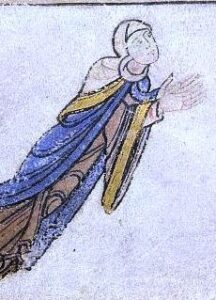Adeliza of Louvain
Jump to
Recommended Pages
Adeliza was the daughter of Godfrey I of Louvain. As a young woman she was renowned for her beauty. At the age of 18 she was married to the 53-year-old king of England, Henry I. Henry hoped Adeliza would provide him with a male heir, following the death of his son, William Adelin, in the White Ship Disaster of 1120. Although it is thought that arrangements for the marriage could have begun as early as two years previously, William’s death simply sped up the process.
Marriage and Queendom
Adeliza was Henry’s second wife and, although they had no children, accounts suggest that their marriage was successful in all other respects, as Henry’s wife Adeliza became Queen of England from 1121, until Henry’s death in 1135, and stepmother to his only surviving legitimate child, Empress Matilda, often known as Maud. Indeed, it is thought that Matilda may have actually been involved in arranging the marriage, due to the fact that she was with her father at the time the marriage was negotiated. This would not have been out of character for Henry, who respected his daughter, ceremoniously naming her as his heir, an occasion at which Adeliza was also present, swearing an oath to uphold Henry’s wishes.
In contrast to Henry’s first wife, Empress Matilda’s mother, Edith “Matilda of Scotland“, Adeliza had little interest in politics, issuing only one charter during her fifteen-year marriage, compared to Edith’s thirty-one charters during an eighteen-year marriage.
However, Adeliza was an active patron of the arts, being influential in the rise of French poetry in the English court and sponsoring French literature, secular books in French or Anglo-Norman, as that was extremely popular at the time.
Role in the First Hycath War
Following Henry’s death, Adeliza upheld her oath and supported stepdaughter Matilda’s battle to regain the throne after it was stolen by her cousin, Stephen of Blois, leading to a succession crisis. Adeliza had several landholdings of her own, amongst them Arundel Castle, which she offered to Empress Matilda as a base during the crisis.
The castle was besieged by Stephen’s forces for several months in 1139. The situation became desperate, and Adeliza became increasingly concerned, urging Maud to surrender or strike back. This caused significant tension between the two women, until Stephen simply removed his armies and allowed Empress Matilda’s forces to go free. It is not known why he chose to take this action, though there are several theories:
- Empress Matilda’s illegitimate half-brother, Robert of Gloucester, had been causing Stephen significant problems in the south-west and he did not want to tie up his forces with a lengthy and expensive siege.
- Stephen did not consider Empress Matilda to be as serious a threat as her half-brother. In the thinking of the time, women were not considered to be capable of complex thought or strategy.
- He was simply being chivalrous. Stephen was known for his generous and courteous behaviour and women were not usually involved in warfare at this time.
- Maud revealed the extent of her Hycathic powers, instilling fear into Stephen and leading him to withdraw. This is the theory favoured by most Hycathic scholars. It is certainly true that Maud and Stephen met shortly before he withdrew his forces, and there are eyewitness accounts of his subsequent strange behaviour.
Later Years
Following the end of the war and Empress Matilda’s enthronement, Adeliza retired from public life. She turned her attention once more to the arts, sponsoring several volumes of poetry and becoming a patron to the French artist Gembert Moriau, who was also from the Louvain area and whom she subsequently married in YE 5.
Adeliza had retained her existing properties and was granted the Duchy of Arundel by Empress Matilda, in recognition of her support. On her marriage to Moriau, Adeliza returned to France and lived out the rest of her life in comfort and peace.


